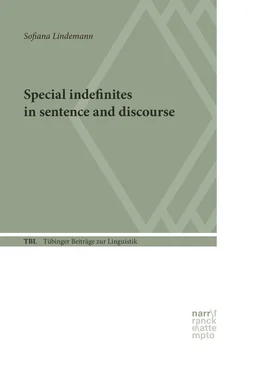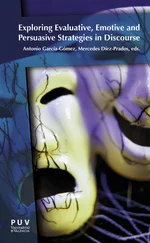| (5) |
I saw √this/ √a man in my dream, dressed as Santa Klaus2. |
The cognitive statuses introduced by Gundel et al. (1993) could be thought of as being in part encoded in the grammar, as a set of constraints on certain lexical items, and in part as information processing mechanisms for the benefit of the hearer (e.g. the use of demonstratives to signal topic-shift). Some interesting questions with respect to the use of a particular type of referring expression in a given discourse are concerned with reference continuation once the referent has been introduced. Is the type of referring expression used by a speaker more than just a backward-looking mechanism into the discourse status and activation level of its associated referent? Are types of referring expressions forward-looking as well, indicating how a referent will be continued in the discourse? That is, given a discourse with several (competing) referents, how do speakers introduce and continue talking about them? The next Sections are dedicated to the discussion of different models of referential management in terms of activation, topicality and expectancy that offer partial answers to these questions. The common denominator of these models on reference tracking is that a referent’s history (i.e. its discourse status according to Prince (1992)) in terms of a set of multiple factors associated with it, affects its current discourse status.
2.2 Accessibility as activation
Assuming that the process of referring is dynamic, constantly changing, and that referents are more or less accessible as the discourse unfolds, different theories of accessibility or salience emerged, as an attempt to capture the correlation between a particular type of referring expression and the discourse features the referent associated with it encodes. In verbal communication, participants keep mental representations of the entities introduced in the discourse (Bransford et al. 1972, Clark and Haviland 1977). These mental representations help discourse participants organize the information at hand by keeping track of the information that was already mentioned and linking the new information to the already established discourse model. Important to note is the fact that it is information that is more or less accessible at a given point in time and not the referring expression per se. In such frameworks, where accessibility is regarded as a gradient category rather than a categorical one, a discourse referent can be more or less accessible. The basic idea behind these approaches is that referring expressions are used to introduce and continue reference to entities with particular referential properties, but also with discourse properties such as an activation level that impacts their accessibility for reference with subsequent anaphoric expressions. Returning now to the difference between definite and indefinite noun phrases, the aforementioned approaches predict that a salient, accessible or activated referent will be introduced by means of a definite noun phrase, whereas non-accessible, non-salient and non-activated referents will be introduced with an indefinite noun phrase.
The term accessibility is used differently in Ariel’s (1990), Lambrecht’s (1994) and Chafe’s (1976) approaches. Ariel uses the term in a more general way as cognitive availability, while for Chafe (1976) and Lambrecht (1994) the term denotes semi-active referents only. Here and throughout this book I use the term accessibility for information more easily retrievable. The approaches to accessibility discussed here propose different (but not necessarily contradictory) explanations for why speakers choose different types of referring expressions. The main aim of this Chapter is to filter out several quantifiable measures of accessibility to be used in Chapters 3 to 5 for measuring the accessibility and the discourse structuring potential of referents headed by this , so’n and pe . While I will describe the main approaches to accessibility to delimit the textual characteristics that contribute to the accessibility of different types of indefinite noun phrases, I will keep an eye on the data to be discussed in more detail in the following Chapters. I will start by discussing the approach to referential management in terms of activation and then present the views on accessibility as topicality and expectancy.
2.2.1 The Accessibility Hierarchy
Starting from the premise that human communication is not an arbitrary exchange between language users in that interlocutors do not switch between different types of referring expressions at random, Ariel (1988, 1990) analyses the systematic patterns behind referring. Cornish (1999) and other linguists proposed a cognitively motivated account of different types of referring expressions, according to which determiners are tied to different cognitive states and/or statuses (i.e. memory locations and attention states). At the heart of the Accessibility Hierarchy (Ariel 1988, 1990) is the interplay between human memory and the types of referring expressions that are responsive to it. Departing form Chafe’s (1976) threefold distinction of activating states (i.e. activated, semi-active and inactive) which, in her view, cannot account for the whole range of data found cross-linguistically, Ariel (1990) advocates in favour of the idea that different types of referring expressions mark different degrees of accessibility of their associated referents. According to this analysis, speakers choose different types of referring expressions to indicate to their addressees the degree of assumed accessibility of their associated referents. In other words, the speaker uses a referring expression to instruct the addressee to retrieve a piece of information from his memory by indicating to him how accessible this piece of information is to him. For Ariel, all types of referring expressions code a different and precise degree of mental accessibility, functioning as markers of accessibility. The prediction made by her theory is that, when an entity is less accessible, the type of referring expression used by the speaker will be more elaborated (e.g. a definite (possibly modified) nominal phrase). And conversely, the higher the accessibility of a referent, the less explicit the type of referring expression chosen by the speaker will be (e.g. a pronoun). What distinguishes Ariel’s approach from Gundel et al.’s (1993) is the observation that for the former, accessibility is affected at any time in the discourse by four important factors, namely: the distance between the anaphor and the antecedent, the competition for saliency between the referents present in an utterance, topichood (i.e. subjecthood) and unity , or whether the antecedent and the anaphor are in the same discourse segment. Recall that for Gundel et al. (1993), the cognitive statuses are encoded as mental representations and are non-negotiable as the discourse unfolds. The Accessibility Theory advanced by Ariel (1988) predicts on the basis of these four factors, the degree of accessibility of a referent at a particular point in the discourse. In turn, the degree of accessibility of a referent will determine the type of referring expression used to pick up that referent. Let us consider example (6), which introduces two referents of different gender, Paul and Ana . According to the Accessibility Theory, the referent associated with the proper name, Paul , is more accessible, as he is mentioned in the immediately following sentence in a topic position (i.e. grammatical subject position). In this case, a pronoun referring back to this referent seems more natural than a full definite noun phrase. The second referent, Ana , is taken up in the immediately following sentence as well. However, as this referent was not introduced in a topical position (i.e. it is realized as a direct object rather than as a subject), the use of a noun phrase to pick this referent up seems more appropriate than referring to it by means of a pronoun.
Читать дальше












